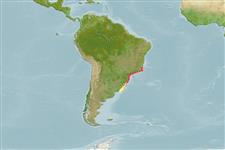Environment: milieu / climate zone / profondeur / distribution range
Écologie
marin récifal; profondeur 0 - ? m (Ref. 40849), usually 0 - 15 m (Ref. 40849). Subtropical; 20°S - 35°S
Western Atlantic: Southern Florida, (USA), Bahamas, Antilles, and coast of South America (Ref. 26938), from Brazil to Argentina (Ref. 3815).
Length at first maturity / Taille / Poids / Âge
Maturité: Lm 20.3, range 20 - 23.1 cm
Max length : 37.8 cm TL mâle / non sexé; (Ref. 57473); poids max. publié: 2.5 kg (Ref. )
Description synthétique
Clés d'identification | Morphologie | Morphométrie
Épines dorsales (Total) : 12; Rayons mous dorsaux (Total) : 13 - 14; Épines anales: 3; Rayons mous anaux: 12 - 14. Large, black, saddle-shaped blotch on upper caudal peduncle (Ref. 26938). Silvery, about nine faint narrow dark bars may be visible on upper two-thirds of body (Ref. 13442).
Body shape (shape guide): fusiform / normal.
Occur in clean turbulent waters along open rocky coasts, usually in surf areas (Ref. 7251). Juveniles are frequently found in littoral pools between rocks (Ref. 9626). Individuals up to 10 cm are caught in shallow waters, often in sandy shores or in seagrass (Thalassia) beds (Ref. 9626). Maximum weight of 2500 g based on confirmed reports from Uruguay (L.A. Pereira, pers. comm., 6/12/01).
Life cycle and mating behavior
Maturité | Reproduction | Frai | Œufs | Fécondité | Larves
Cervigón, F., 1993. Los peces marinos de Venezuela. Volume 2. Fundación Científica Los Roques, Caracas,Venezuela. 497 p. (Ref. 9626)
Statut dans la liste rouge de l'IUCN (Ref. 130435: Version 2025-1)
Menace pour l'homme
Harmless
Utilisations par l'homme
Pêcheries: intérêt commercial mineur; pêche sportive: oui
Outils
Articles particuliers
Télécharger en XML
Sources Internet
Estimates based on models
Preferred temperature (Réf.
123201): 21.1 - 25.8, mean 23.4 °C (based on 68 cells).
Phylogenetic diversity index (Réf.
82804): PD
50 = 0.5000 [Uniqueness, from 0.5 = low to 2.0 = high].
Bayesian length-weight: a=0.01230 (0.00569 - 0.02662), b=3.04 (2.87 - 3.21), in cm total length, based on LWR estimates for this Genus-body shape (Ref.
93245).
Niveau trophique (Réf.
69278): 3.1 ±0.39 se; based on food items.
Résilience (Réf.
120179): Milieu, temps minimum de doublement de population : 1,4 à 4,4 années (Preliminary K or Fecundity.).
Fishing Vulnerability (Ref.
59153): Low to moderate vulnerability (28 of 100).
🛈
Climate Vulnerability (Ref.
125649): Moderate to high vulnerability (51 of 100).
🛈
Nutrients (Ref.
124155): Calcium = 34.1 [14.0, 57.1] mg/100g; Iron = 0.607 [0.319, 1.135] mg/100g; Protein = 20.2 [19.1, 21.3] %; Omega3 = 0.218 [0.116, 0.427] g/100g; Selenium = 15.9 [7.5, 29.7] μg/100g; VitaminA = 48.4 [14.4, 155.5] μg/100g; Zinc = 0.867 [0.571, 1.303] mg/100g (wet weight);
